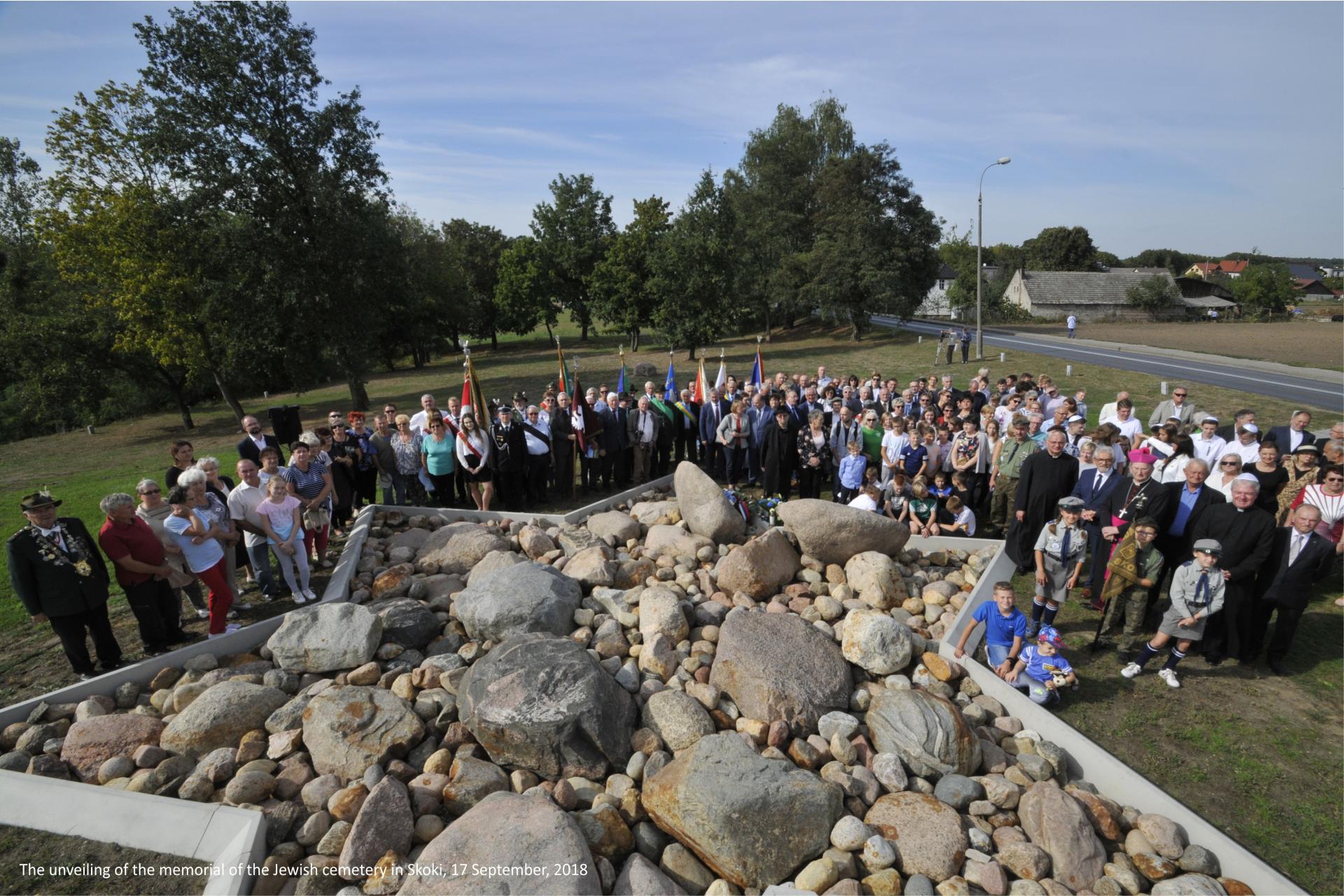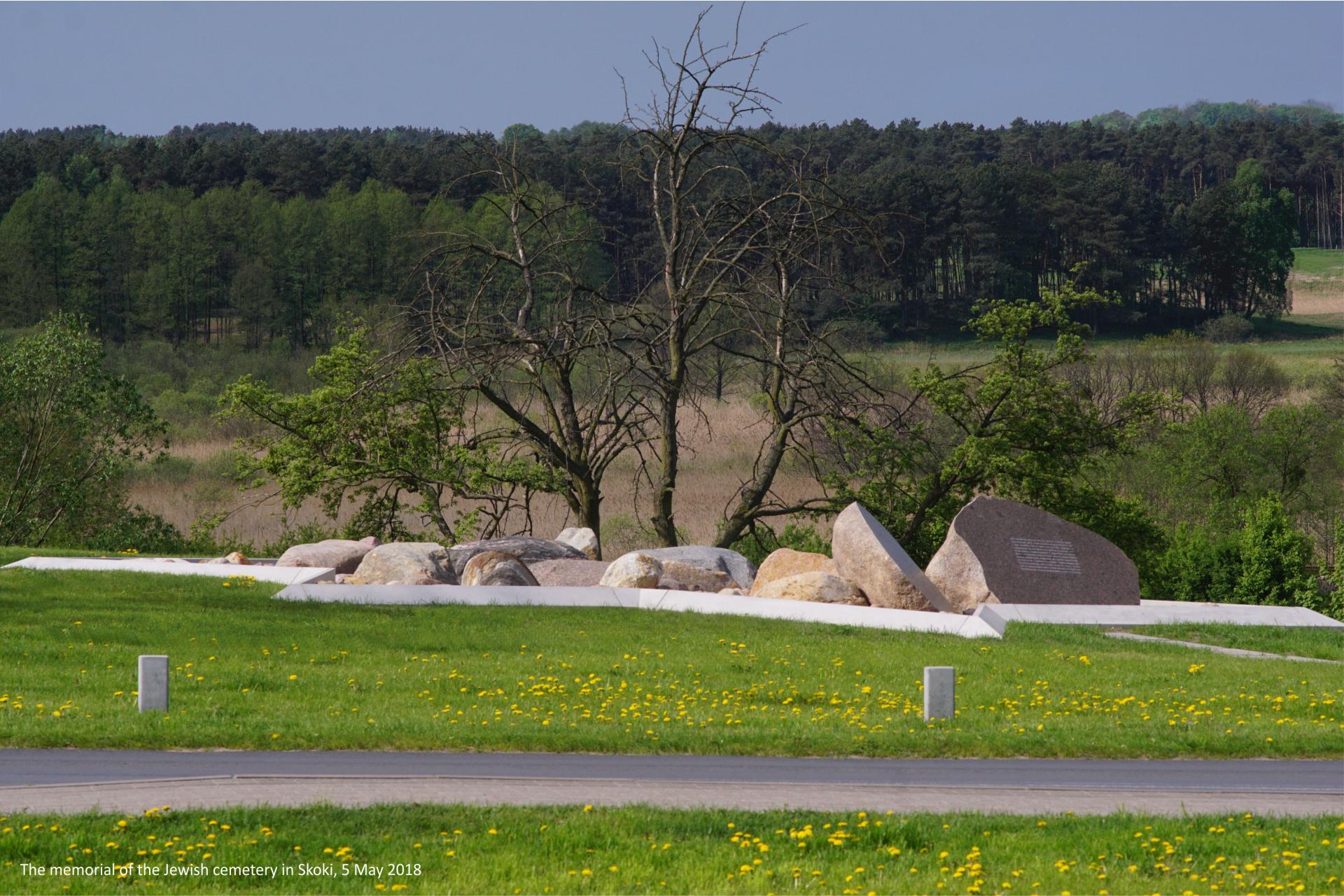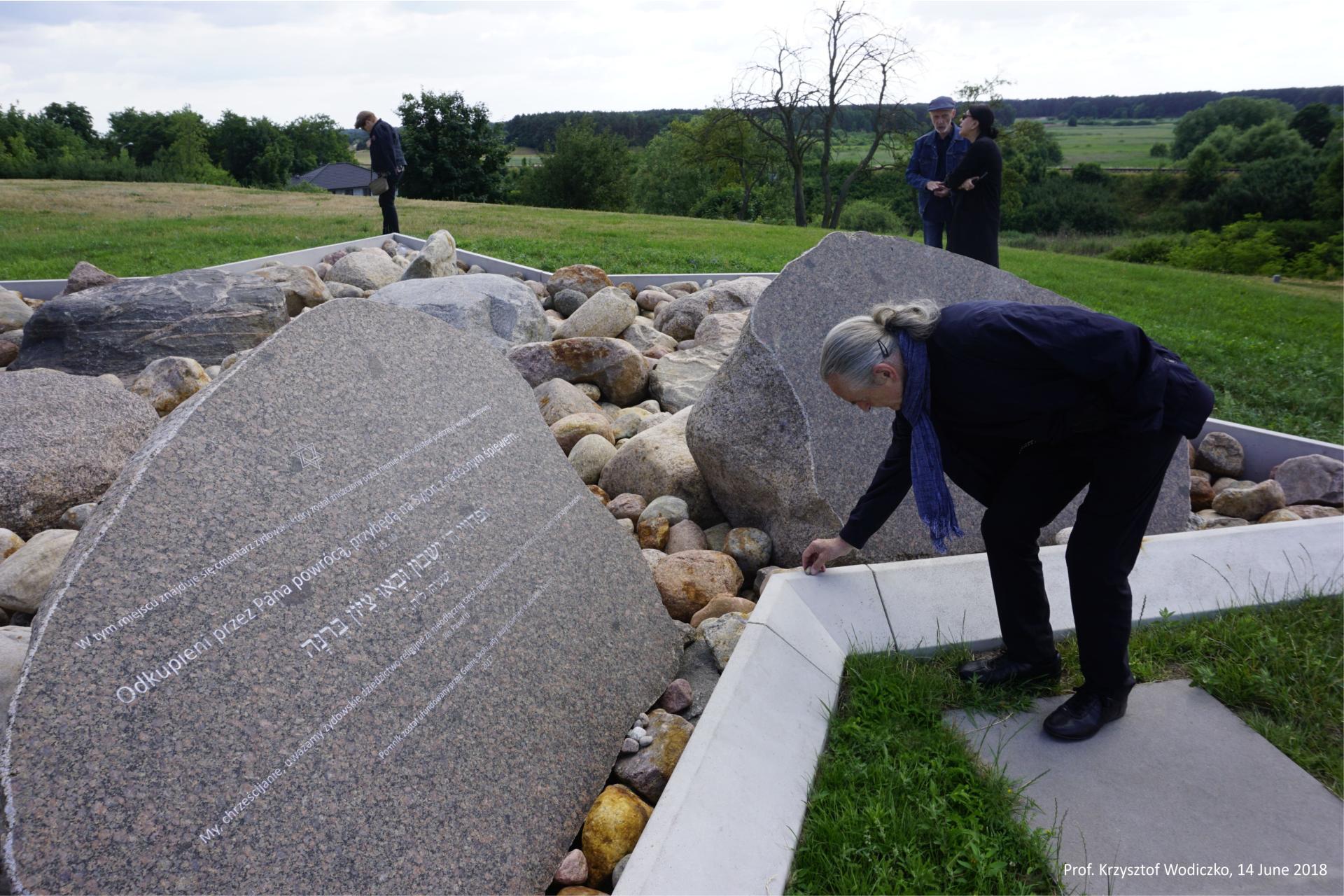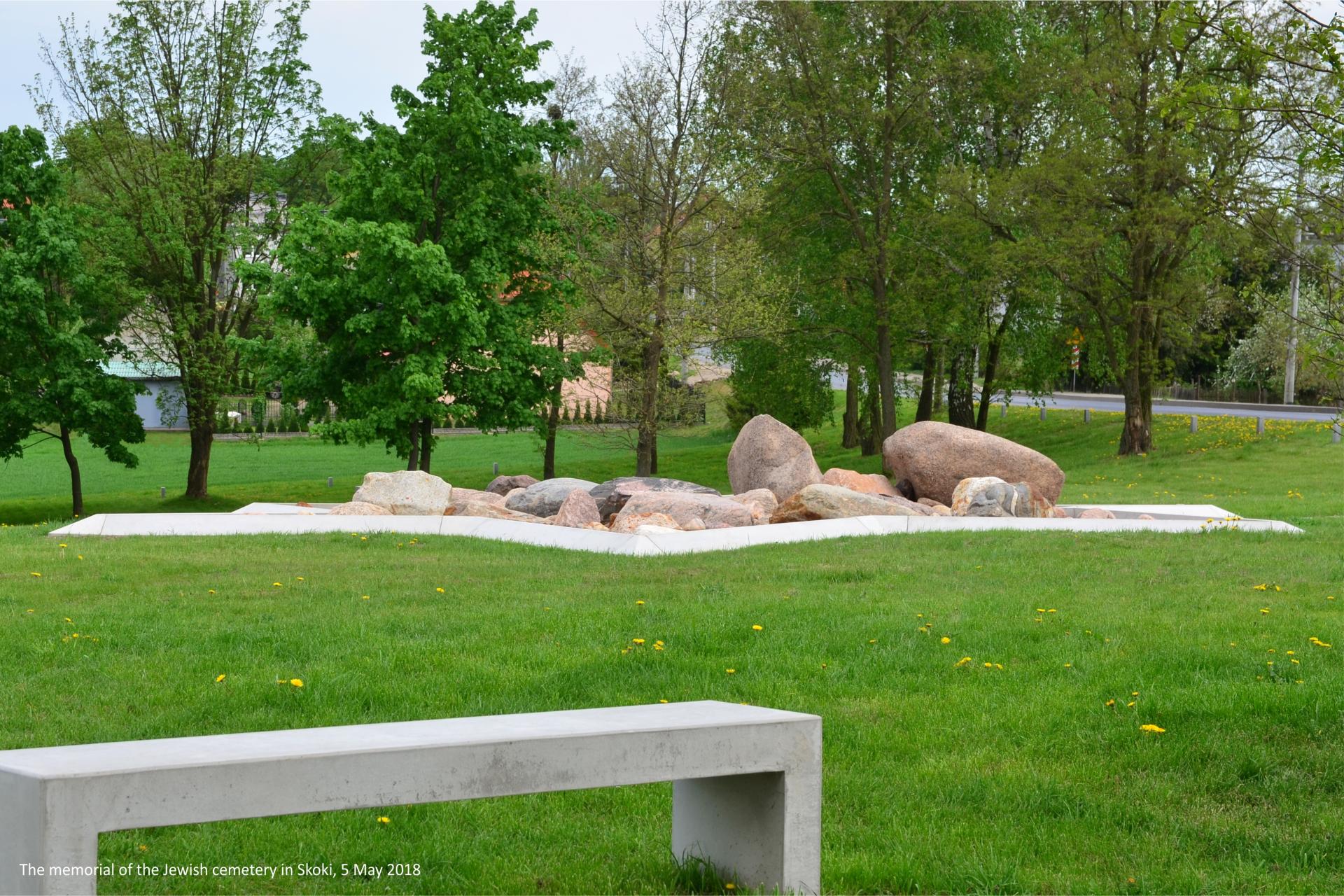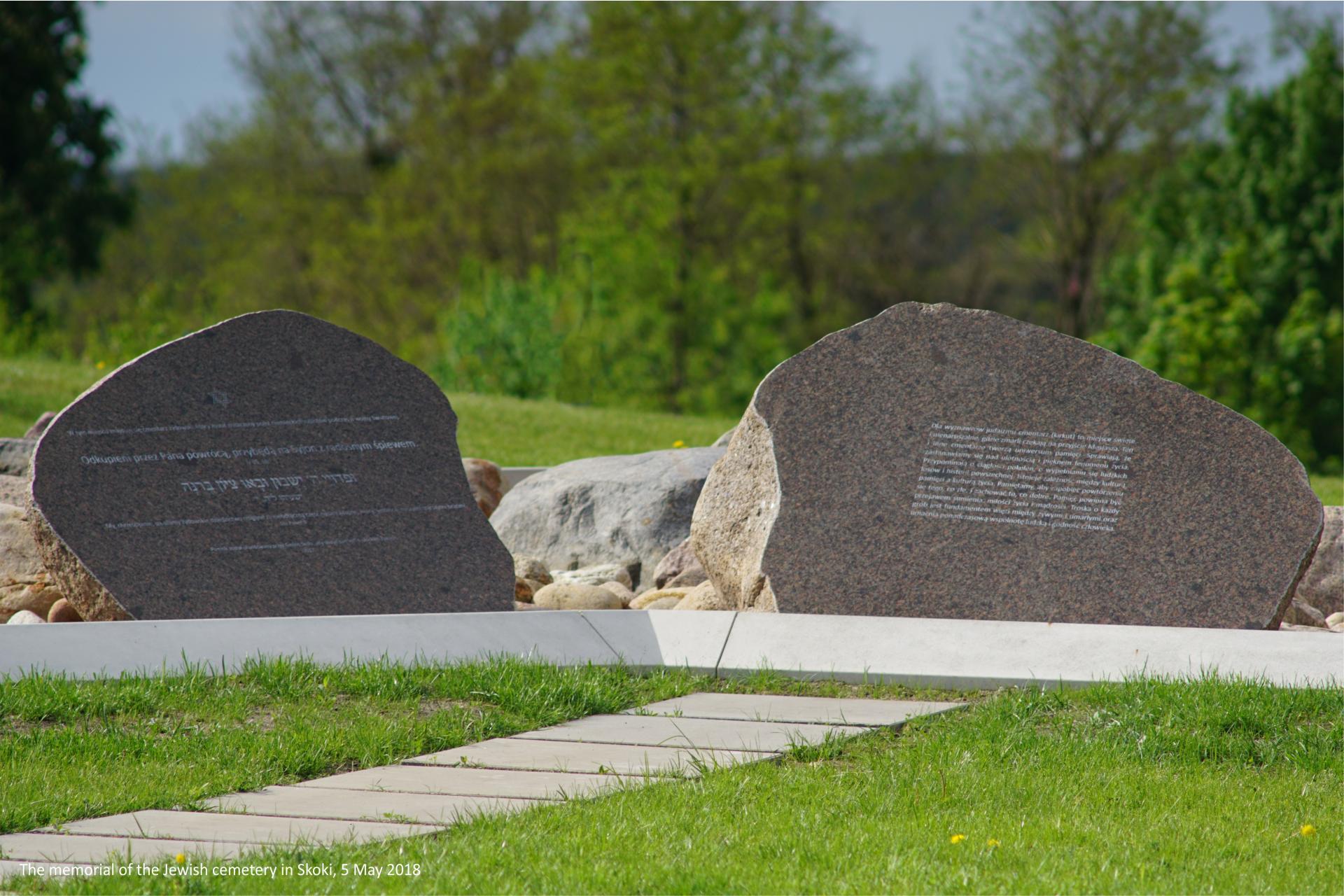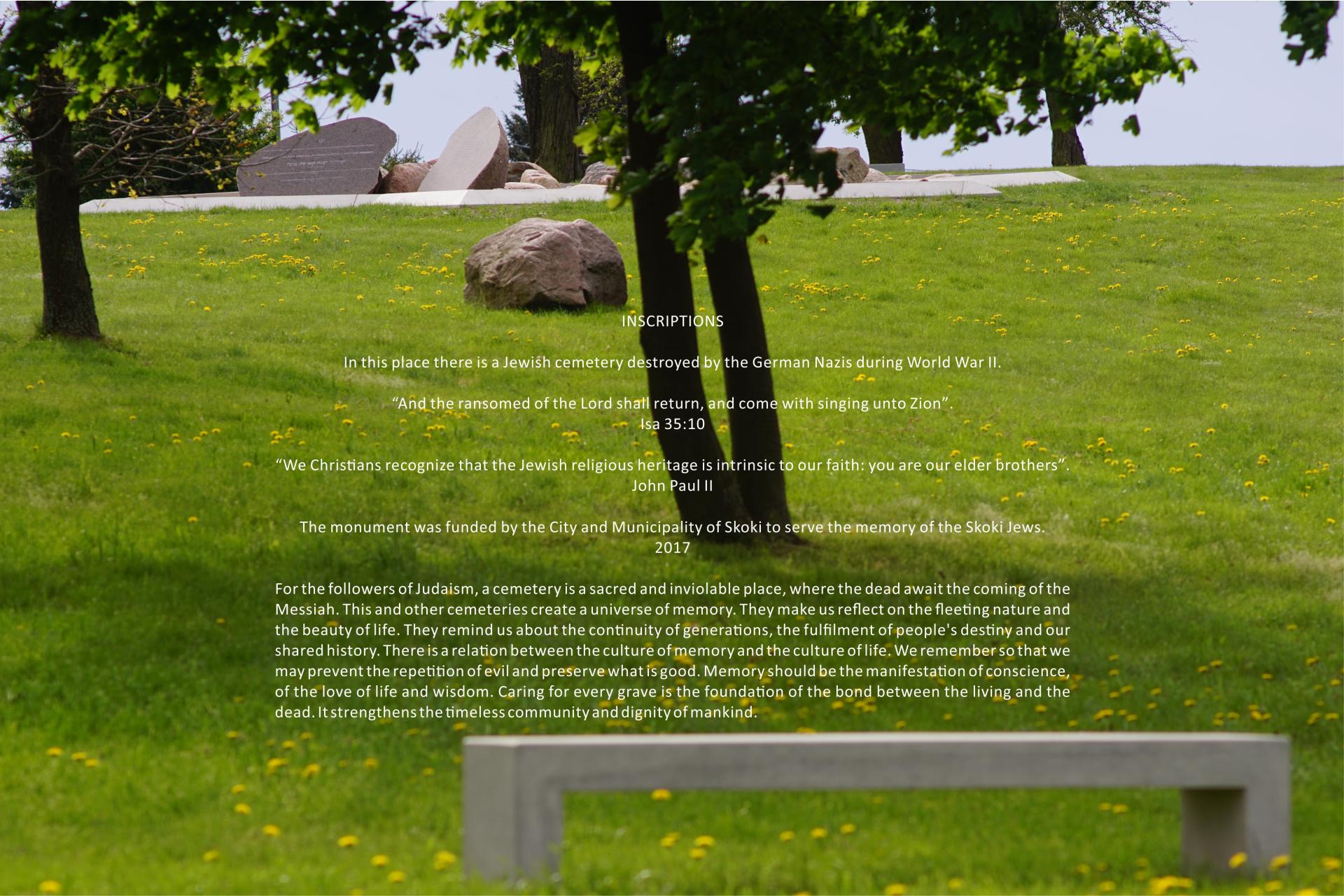The Jewish cemetery memorial in Skoki
Basic information
Project Title
Full project title
Category
Project Description
Without memory, there can be no civilisation, no society and no future. This memorial was established thanks to the inhabitants of the Skoki Municipality and speaks to all of us with its presence in the Jewish cemetery, with its symbolism of the star and stones, and with the moving words engraved on it. It tells us about the chain of generations, about the human community and about human dignity. It reminds us that caring for graves establishes a bond between the living and the dead.
Project Region
EU Programme or fund
Description of the project
Summary
The Star of David set in concrete and filled with stones is a symbol of remembrance of the people buried in this cemetery. The inscriptions indicate its religious and educational function. Linked with ethics, memory gives meaning to the past and to the future. After a few decades, thanks to people of good will and their ethical memory, the Jewish cemetery in Skoki has once again become an object of respect.
The project was recommended by
Dr Piotr M.A. Cywiński, Director of the Auschwitz-Birkenau State Museum
Iwona Migasiewicz, President of the Society of the Friends of the Town and Vicinity of Skoki
Michael Schudrich, Chief Rabbi of Poland
Lena Stanley-Clamp, Director of the European Association for Jewish Culture
Prof. Krzysztof Wodiczko, Harvard University
FRAGMENT OF THE INSCRIPTIONS ON THE MEMORIAL
“In this place there is a Jewish cemetery destroyed by the German Nazis during World War II. (...)
The monument was funded by the City and Municipality of Skoki to serve the memory of the Skoki Jews.
For the followers of Judaism, a cemetery is a sacred and inviolable place, where the dead await the coming of the Messiah. This and other cemeteries create a universe of memory. They make us reflect on the fleeting nature and the beauty of life. They remind us about the continuity of generations, the fulfilment of people's destiny and our shared history. There is a relation between the culture of memory and the culture of life. We remember so that we may prevent the repetition of evil and preserve what is good. Memory should be the manifestation of conscience, of the love of life and wisdom. Caring for every grave is the foundation of the bond between the living and the dead. It strengthens the timeless community and dignity of mankind.”
Key objectives for sustainability
The key objectives of my project were achieved thanks to my cooperation with local social activists and regionalists operating in the Society of the Friends of the Town and Vicinity of Skoki. I received the support of these people and I have great respect for them. They are genuinely passionate about the local history and have a deep knowledge of it. We owe to them the discovery of a list of people buried in the Jewish cemetery in Skoki and many activities taken with a view to sustaining memory and perpetuating history.
The sustainability of the achieved goal depends on the durability of the commitment of these people. Conversely, their involvement is influenced by the presence of a monument. Now they are the guardians of this memorial and memory about local history. This monument is also a symbol of their achievements in the field of memory work. Without their understanding and support, this monument would not make sense.
Tadeusz Kłos – Mayor of Town and Municipality of Skoki was the initiator of the memorial project. His initiative was understood and supported by the Town and Municipality Council. I am grateful for the trust they placed in me. I trusted them too and did not let them down. Mutual trust is essential to the success and sustainability of such initiatives. Kłos wrote that the 650-year history of Skoki, which was a place of coexistence of different cultures and religions, obliges us to be mindful of our memory and to respect one another. However, one cannot idealize the past and censor historical truth, because truth, as we know, sets us free and purifies. Remembrance is a lesson that needs to be constantly learned. Remembering the past means being committed to the future.
I hope that will be possible to find and bring back to the cemetery the matzevot that used to stand in this place. Perhaps it will be possible not to forget about memory.
Key objectives for aesthetics and quality
In art, aesthetics meets ethics. The aesthetic quality of the visual form is an ethical value. Concern for the culture of memory must go hand in hand with care for the aesthetic culture. The freedom to decide about the form and content of the inscriptions, allowed me to combine all the elements of the monument into a whole. The project was consulted with outstanding experts. Prof. Krzysztof Wodiczko (Harvard University) wrote a touching letter:
“I am deeply moved, morally strengthened and at the same time full of appreciation for the inhabitants of Skoki, the city authorities, the artist, and all the creators of the monument – for their symbolically meaningful act of remembrance, magnificent in its ethical awareness and message. (...)
I am convinced that my mother, a Jewish Holocaust survivor and witness, if she were alive today and could see the memorial, would have tears of deep emotion and gratitude in her eyes. She would think of her parents, murdered somewhere outside the death camps, and of her whole family, wiped out by the Holocaust from the surface of the earth. She would think, touched, of all those noble inhabitants of towns and villages who, risking their lives hid and saved her and me. She would no doubt think about the noble citizens of Skoki, who have today contributed, with this monument and this commemorative act, to the preservation of the right of the Jews to be part of Poland's tragic collective memory. She would also think that this monument is not only a painful reminder, but also a necessary warning of and opposition to the danger we witness today of repeating past tragedies, injustices and violence. (...)
It will now be a great ethical marker and signpost on the way to a better tomorrow for Polish Jews, for all those who represent or come from social and religious minorities, for all the people in Skoki, for all of us in Poland and for the whole world.”
Key objectives for inclusion
The key objective of my project was to save the destroyed cemetery from oblivion and desecration. The best illustration of the achieved degree of inclusion is a photo of the monument unveiling ceremony.
At every stage of the design, I asked for discussion and approval. The project received public support. The more people involved in the project the better. The author must be genuinely open to close personal relationships with the inhabitants of the place where he is carrying out the monument project. The monument integrates the Skoki community. Direct contact with the public, conversations and explaining the concept of the monument are the only way to communicate and integrate. These are touching moments.
The Society of the Friends of the Town and Vicinity of Skoki gave me moral support, and after the unveiling of the monument, honored me with a nice and honorable title of honorary member. The memorial drew the attention of regionalists and historians to the little-known history of the Jewish inhabitants of Skoki. The earliest known references to Jewish settlement come from the books of the town court from the turn of the 18th century, in which it was noted that Skoki had Jewish inhabitants and that they owned houses there. But the history of Jews in Poland dates back at least 1,000 years. For many centuries, Poland was home to the largest and most significant Jewish community in the world. My other works related to Jewish remembrance are documented on my website http://www.januszmarciniak.pl/home (e.g. “Atlantis”, “9/09/1939”, “Alphabet”, “ACBHM”, “Words”, “Synagogue”, “Haggadah”, “From Those You Saved”, “Memorial in Pila”, “Pavement of Memory”).
Many years of experience and interest in the issues of memory help me in my artistic work, with particular emphasis on the commemoration of the Holocaust and Jewish cemeteries. This is the most important direction of my artistic work.
Results in relation to category
Preserved and transformed cultural heritage it is the foundation of social bonds and indyvidual empathy. The positive impact and results of caring for cultural heritage are expressed by an increase in knowledge and understanding of history, which means a better understanding of the present day and the value of democracy. Democracy is about sharing responsibility for everything, and for the culture of memory, which deepens our humanism and reveals the meaning of a single life and community – civil society.
The culture of memory must go hand in hand with care for aesthetic culture.
Activities in the provinces, far from big cities, are especially important. The result of the impact of projects such as my project is expressed in an increase in social awareness, a reduction or complete elimination of manifestations of anti-Semitism and xenophobia. The truth of the monument's moral message must be consistent with objective historical sources and have a universal dimension. Only this truth embraces and cares for us. This is usually the belated truth, the truth of the victims, the truth about the harm done to the weaker. Such projects have a direct impact on education, textbook content and history lessons. They become a destination for excursions and reflections. The monument is a helpful resource for history teachers and a topic of lessons (http://www.gmina-skoki.pl/news/culture/144340-spolecznosc-zydowska-w-dawnych-skokach/).
How Citizens benefit
The construction of the monument was entrusted to a local construction company that employs the inhabitants of Skoki. For them, it was not only a lesson in history and empathy, but the awareness that they would also show their building skills. From the beginning, they considered this project "their" and are proud that they could implement it.
The monument influences the thinking of the inhabitants. I tried to do everything to make the monument have a positive impact on residents and tourists. That its message would not divide, but connect people. Linked with ethics, memory gives meaning to the past and to the future. Memory (remembering) is the cornerstone of existential awareness. This awareness is plagued by difficult and perennial questions. For instance, questions about why this cemetery and so many others have been destroyed? Or the universal question posed by the German philosopher Gottfried Leibniz: “Let us first ask where evil comes from? If there is God, whence evil? If there is no God, whence goodness?”. Emmanuel Lévinas, a French philosopher of Jewish origin, replied to the above questions in his writings. From the perspective of the “chasm in history” (his definition of the experience of Auschwitz), he wrote this magnificent sentence: “The love of God is the love of the Torah. This means that the recognition of goodness is more important than the love of God. Or the real love of God is the love of goodness”.
The unveiling has generated some press releases and coverage. Residents take care of the monument. Descendants of Jews buried in this cemetery and tourists come from all over the world to Skoki.
https://sztetl.org.pl/en/towns/s/1812-skoki/120-news/182293-skoki-official-ceremony-at-the-jewish-cemetery
http://www.gmina-skoki.pl/news/culture/131943-skocki-cmentarz-zydowski-oficjalnie-upamietniony/
https://www.facebook.com/GminaSkoki/posts/1828461193870320
Innovative character
The innovative character of this project, which belongs to the field of art, is based on progress in the domain of artistic concept and an inventive iconographic solution. The aesthetics of the visual form is completely original. The content of the inscription is a very important element of the monument. I have spent a lot of time editing this inscription. One fragment: “This and other cemeteries create a universe of memory. They make us reflect on the fleeting nature and the beauty of life. They remind us about the continuity of generations, the fulfilment of people's destiny and our shared history. There is a relation between the culture of memory and the culture of life. We remember so that we may prevent the repetition of evil and preserve what is good. Memory should be the manifestation of conscience, of the love of life and wisdom. Caring for every grave is the foundation of the bond between the living and the dead. It strengthens the timeless community and dignity of mankind.”
My focus as an academic teacher is to convey the value of socially engaged art, and likewise my personal projects remain involved in social life and ethics. In modern Poland there are but select “islands of memory”, where these historical relations and remembrance are present among other concerns of current life. The project contributes to making that process wider, and at the same time, more locally rooted.

